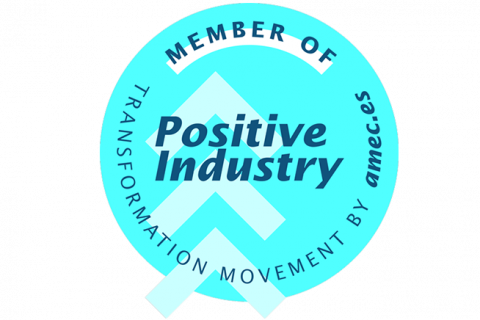
-
Company
-
We talk your language
TMI is your partner for bagging, palletizing and stretch-wapping systems.
- About us
- Talented people
- News
-
-
Solutions
-
Complete bagging lines
TMI manufactures complete bagging lines: from the dosing of the finished product to the protection of the load. We supply bagging machines, palletizers and stretch-wrapping systems that suit your needs. Browse through our portfolio and find the optimal solution for your end of line.
- Bagging systems
- Bag palletizing systems
- Pallet stretch-wrapping
- Industry 4.0
-
-
Industries
-
Solutions that fit your project
We develop bagging and palletizing solutions for different industries. Choose yours to see the solutions that best suit your needs.
- Food
- Agri-food
- Chemicals & petrochemicals
- Construction & mining
- Recycling
-
- Services
- Contact
- Ask for a quotation
-
Company
-
We talk your language
TMI is your partner for bagging, palletizing and stretch-wapping systems.
-
-
Solutions
-
Complete bagging lines
TMI manufactures complete bagging lines: from the dosing of the finished product to the protection of the load. We supply bagging machines, palletizers and stretch-wrapping systems that suit your needs. Browse through our portfolio and find the optimal solution for your end of line.
-
-
Industries
-
Solutions that fit your project
We develop bagging and palletizing solutions for different industries. Choose yours to see the solutions that best suit your needs.
-
- Services
- Contact
We talk your language
News
Palletizer Selection Guide: Find the Ideal Solution for Your Business
February 29, 2024
Discover how choosing the right palletizer can transform your palletizing operations, enhancing efficiency and safety on your production line.
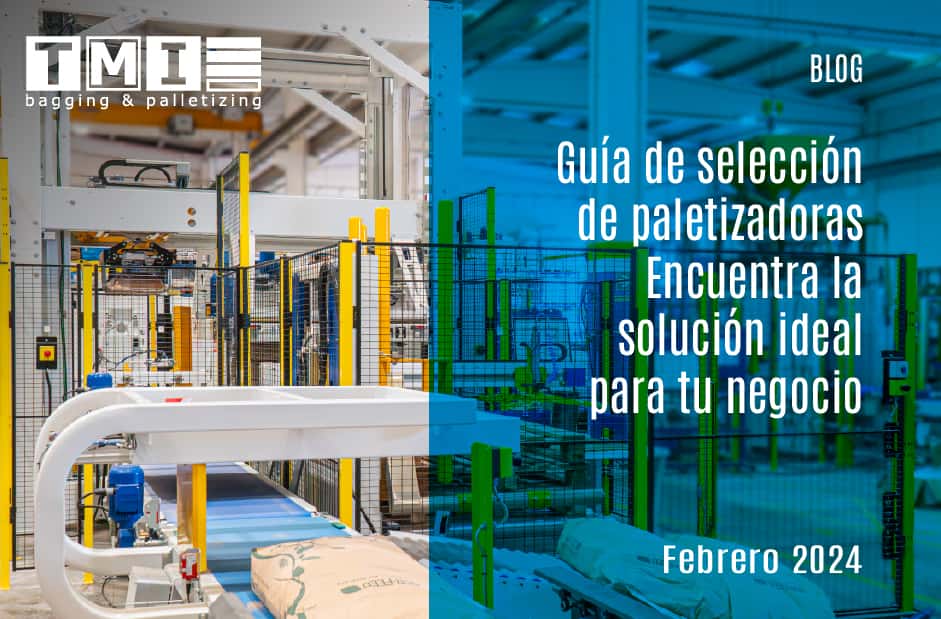
Discover how choosing the right palletizer can transform your palletizing operations, enhancing efficiency and safety on your production line.
In the world of palletization, selecting the appropriate type of palletizer is crucial. In this blog, we will explore the various types of palletizers that TMI offers, providing an objective and consultative perspective to meet the specific needs of each customer.
Palletization is the process of automating and stabilizing the load, ensuring efficient and safe handling of products.
In the vast world of palletizers, there are different approaches to tackling the task of organizing and stabilizing the load on a pallet. We present a detailed overview of two main categories: palletizers that form layers and those that do not.
Palletizers that do not form layers (robots and gantry)
Within this category, two main types stand out:
Robotic Palletizers
Robotic palletizers, with their anthropomorphic design, bring a high level of automation and reliability to product handling. It is a robotic arm that picks up bags, boxes, bales, and places them on a pallet with mathematical precision, usually using a gripper or vacuum system.
They are particularly efficient when it comes to managing substantial volumes, providing a quick and precise approach to palletization. However, it is important to note that, compared to other systems, robotic palletizers may have limitations in terms of the quality of load arrangement.
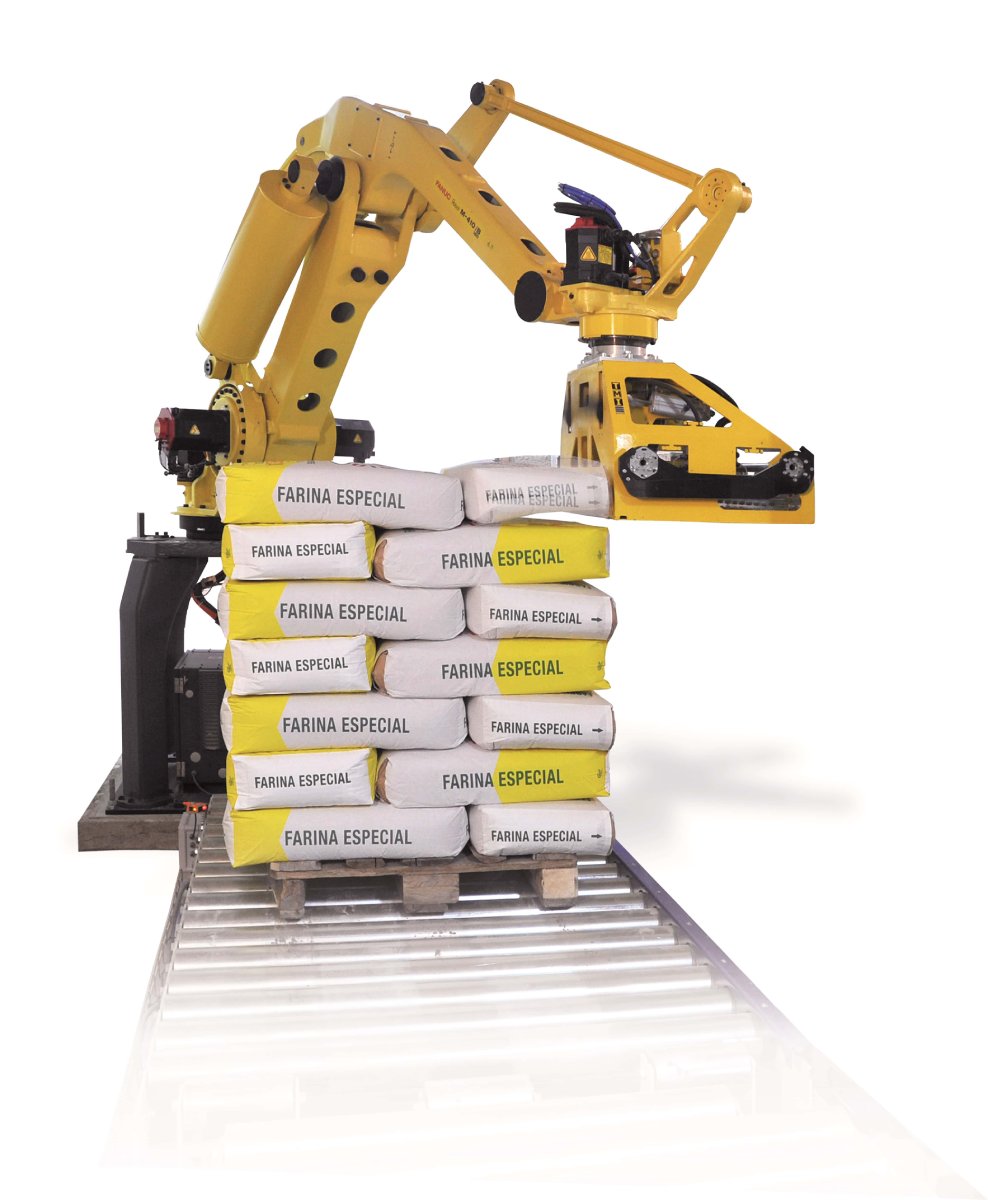
Gantry Palletizers
Gantry-type palletizers, also known as Cartesian palletizers, offer an automated approach, though at a slightly slower pace compared to their robotic counterparts.
This type of palletizer is versatile and suitable for various applications, making it a feasible option for those seeking automation with flexibility. They are primarily used for end-of-line applications with production levels ranging from low to medium (up to 420 bags/hour), where bags need to overlap (easy-open bags), although they can also palletize valve bags or FFS-type bags seamlessly.
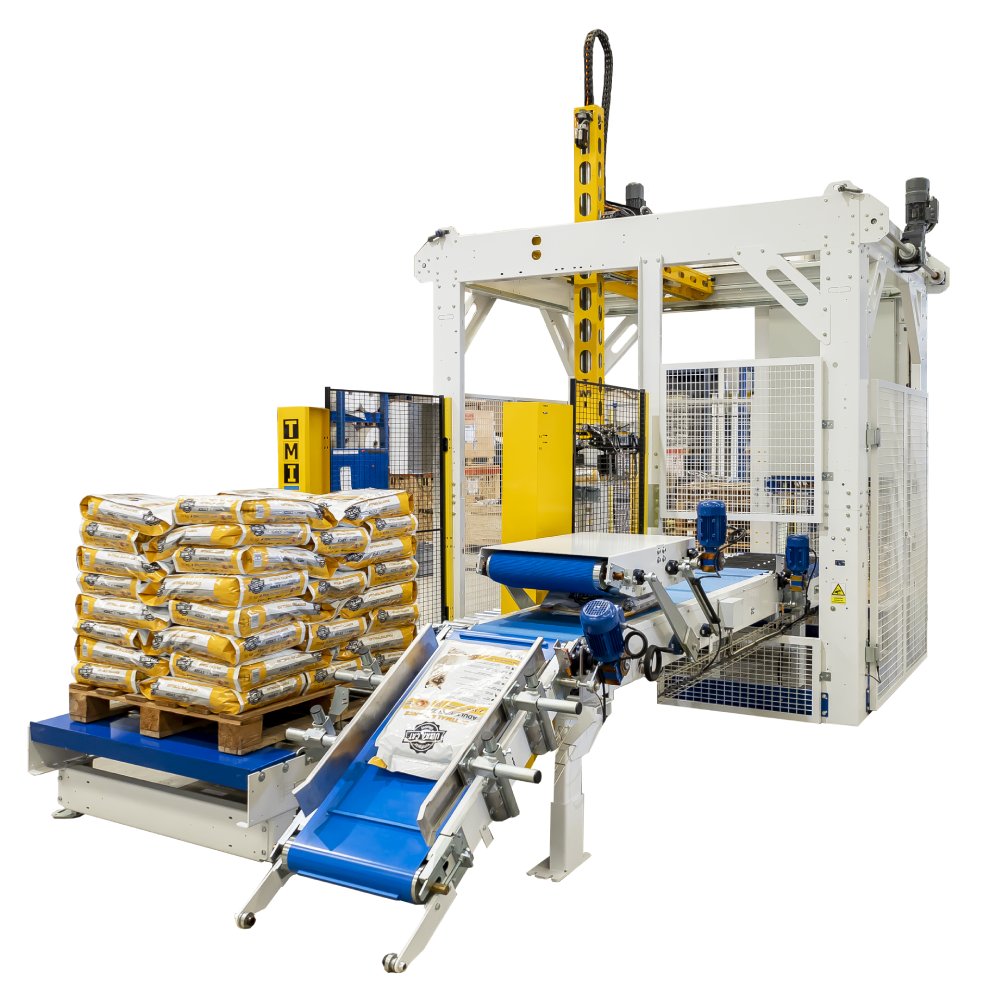
Palletizers that form layers
In this category, palletization is addressed by forming layers. This approach prioritizes quality by organizing product layers precisely and stably. Load stability is established as the key criterion for evaluating the performance of these palletizers. This method aims to ensure that the load arrangement is optimal in terms of stability and presentation.
This type of palletization works as follows: bags are elevated to the palletization position, i.e., the layer-forming platform, where four side devices are responsible for pulling the bags and forming each layer. The layers are placed directly on gates that open to stack each one on top of the previous.
Layer palletizers are an excellent choice for medium to high productions where products are bagged in valve or FFS bags that do not require overlapping.
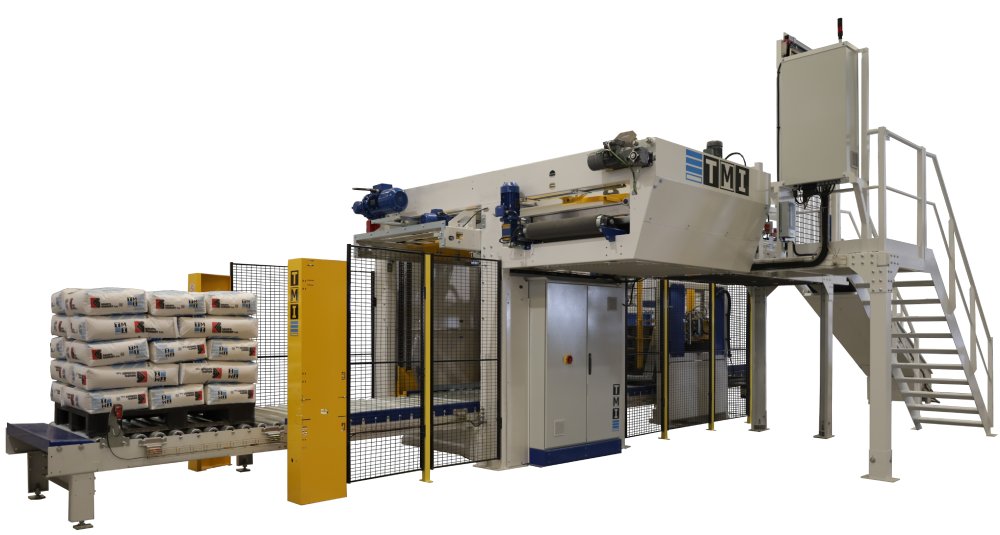
Hybrid Palletizers
Hybrid palletizers have been designed with the purpose of palletizing easy-open bags at high speeds. These systems merge features of robotic palletizers and layer palletizers to achieve superior levels of efficiency in the palletization process of easy-open bags.
Although they share similarities with high-performance palletizers, hybrid palletizers use robotic grippers and Cartesian axis systems for layer formation, always assisted by lateral pushers. This way, enhanced performance is achieved, preserving the integrity of the bag and ensuring optimal pallet stability.These different types of palletizers offer specialized solutions for various needs, allowing customers to select the option that best suits their specific palletization requirements.
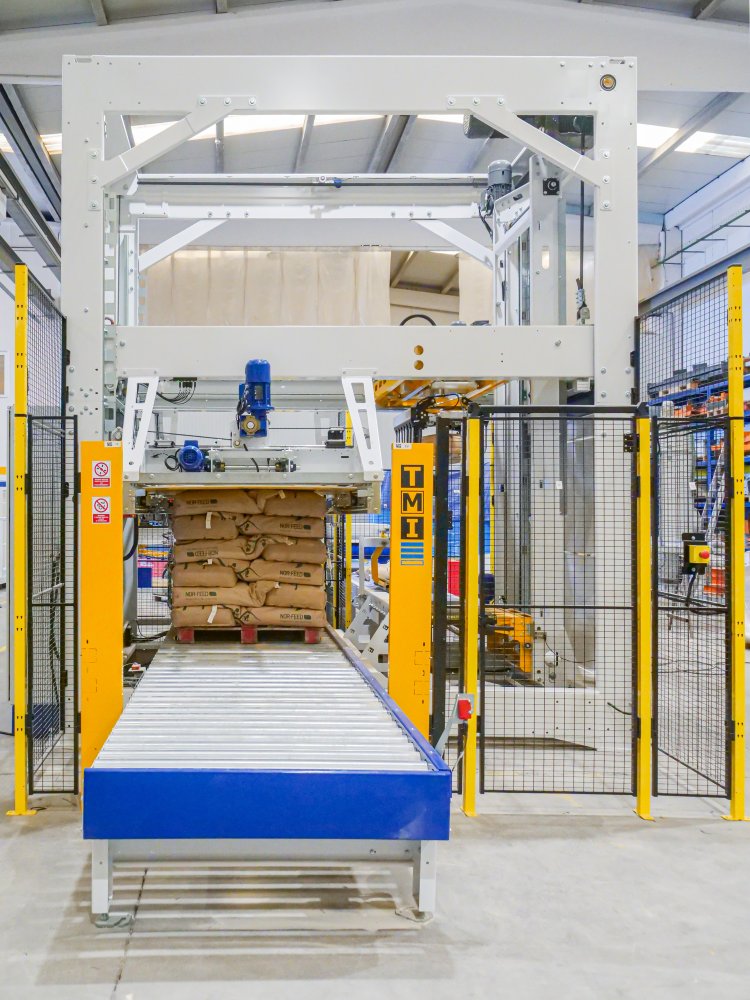
Key factors for palletizer selection:
Production speed (bags per hour):
Production speed is crucial for maintaining workflow and meeting demand. A palletizer that does not meet the speed requirements set by the customer or product can create bottlenecks in production. Current and future capacity should be evaluated, considering possible expansions or increases in demand.
Bag type (overlapping or not):
The type of bag has a direct impact on how materials are handled during the palletization process. Some palletizers may be more suitable for certain bag types than others. It is essential to consider factors such as material strength, bag shape and size, as well as ease of stacking.
Maximum pallet height:
Maximum pallet height influences load stability and storage and transportation capacity. Height restrictions in storage and transportation must be considered, along with compliance with relevant safety regulations.
Available space in the factory:
Space availability can limit the choice of palletizer type and size that can be installed. Measuring available space is crucial, taking into account the need for storage areas or maneuvering space around the palletizer.
Need for simultaneity on multiple lines:
The ability to handle multiple production lines simultaneously can be crucial for large and diversified operations. It should be assessed whether a centralized system capable of managing multiple lines is required or if it is more suitable to have independent systems.
With over 25 years of dedication and experience in the industry, TMI has established itself as an expert reference in industrial palletization solutions. The company stands out for its ability to offer customized responses to each challenge, supported by a solid knowledge accumulated over the years.
In particular situations, such as projects related to the human or pet food sector, TMI has faced challenges that have required more complex palletizing solutions. These specific challenges have driven the continuous development of the company, resulting in a diverse range of six palletizing solutions. Each of these solutions has been conceived to address the unique needs of different contexts and products.
The ILERPAL L palletizer stands out as a concrete example of TMI's balanced philosophy. This solution not only offers cost competitiveness but also ensures exceptional levels of quality and automation. ILERPAL L exemplifies TMI's commitment to finding the perfect balance between the benefits provided by the solution and the investment made. It represents a versatile and efficient option that responds to changing market demands and the specific needs of each customer.
Discover Ilerpal L - view video
At TMI, we not only offer palletizers but solutions tailored to every challenge, raising the standard in the industrial palletization industry. Consultative selling based on our experience is the cornerstone of our approach to help customers make the best decision.
Ready to discover the perfect solution for your palletization? Contact us now!
Next article
April 02, 2024
Commitment to after-sales service, strengthening bonds, and building trust through adaptability and continuous excellence.

TMI Técnicas Mecánicas Ilerdenses SL in the framework of the ICEX Next Program, has been supported by ICEX and co-financed by the European ERDF fund. The purpose of this support is to contribute to the international development of the company and its environment.

Company
Address
Polígono Industrial Camí dels Frares,
C/ Alcarràs, parc 66 - 25190 - Lleida · SPAIN Tel. +34 973 25 70 98



